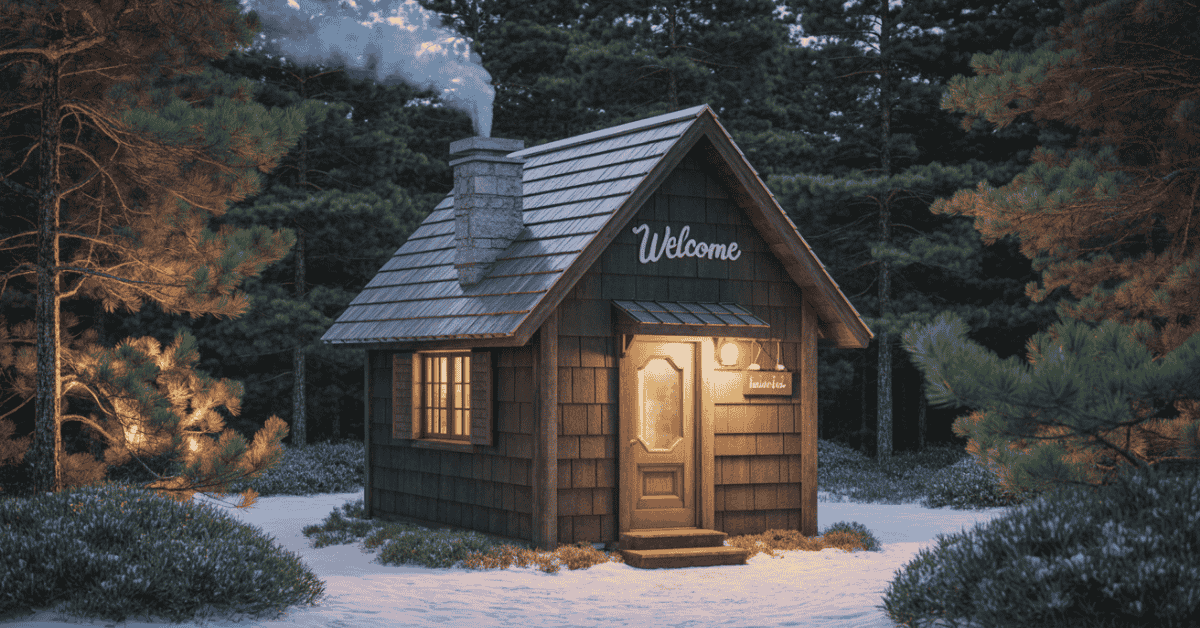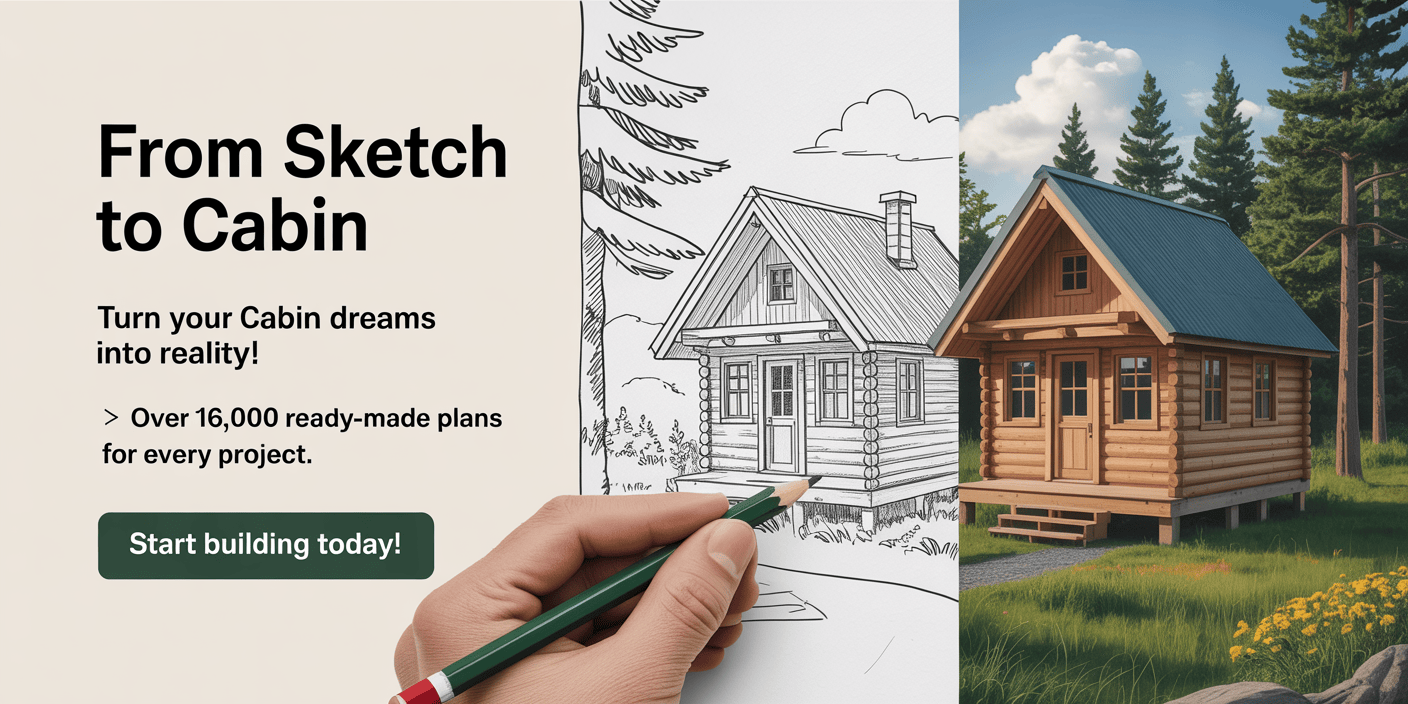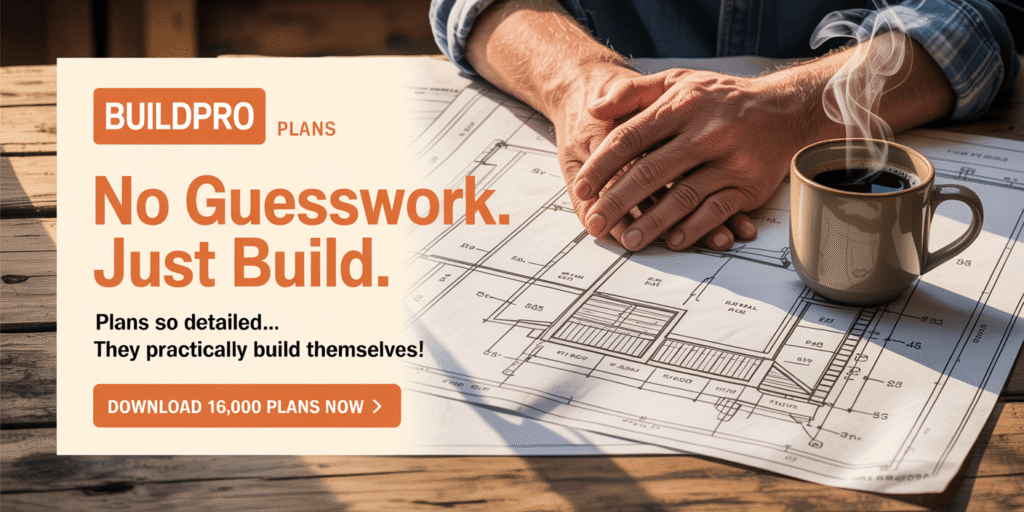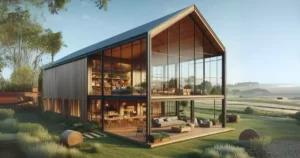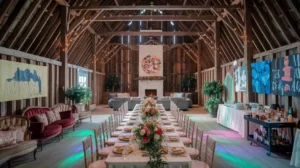The average new U.S. home is now over 2,200 square feet. Yet, many cabins are built under 1,000 square feet and cost less. With a clear plan and steady build, you can save a lot.
This guide will teach you to plan, price, and build a small cabin confidently. You’ll receive a blueprint and a roadmap for finding plans, selecting materials, and scheduling each step. You’ll also learn how to harvest wood, build a moisture-safe base, and finish with practical roofing.
Small cabins come in many styles, from rustic to modern. They can be tiny or up to 1,000 square feet. You can find free plans or buy them from brands like The Plan Collection or Houseplans for $129 to $290.
A good plan set includes blueprints, directions, photos, materials lists, and cutting lists. You’ll use these to lay footings, pour a raised muret, fit logs, frame doors and windows, and set beams and gables. You’ll also decide on gap sealing and finishes like recycled cement tiles.
By the end, you’ll know which design fits your budget and what your costs will be. You’ll also know how to turn your plans into a real cabin. Let’s start smart and build small, the right way.
Key Takeaways
- You can build a quality cabin under 1,000 sq. ft. by following a compact wooden house tutorial with a simple cabin construction blueprint.
- Choose free or paid wooden house design small cabin plans; paid sets often add customization, support, and clearer details.
- Estimate costs by square-foot tiers (under 500, 1,000, and 2,000 sq. ft.) to keep your budget honest from day one.
- Cabin kits can include plans, precut materials, or a shell, and reputable makers may offer pro assembly if you need help.
- Real-world steps matter: raised concrete muret, horizontal log settling, split-log openings, and recycled tile roofing.
- Seal gaps with clay, cement, or sawdust-and-glue to match your climate, budget, and maintenance goals.
- Finish with smart salvaged elements—doors, windows, and roofing—to save money and add character.
Getting Started with Wooden House Design: Scope, Budget, and Build Path
Start by deciding on the size of your wooden cabin: tiny, small, or modest. Match your goals with your timeline, skills, and budget. Choosing the right materials for your site is key to saving money and avoiding headaches.
Start simple, design smart, and plan for delivery, codes, and weather from day one.
Choosing DIY vs. kit vs. pro-built for affordability and control
DIY gives you full control and saves on labor costs. A compact wooden house tutorial guides you. Kits from brands like Jamaica Cottage Shop offer pre-cut packages, saving time and reducing waste.
Some kit makers can connect you with crews if you need help. Pro-built cabins are faster and come with a warranty. But you’ll lose some flexibility. Think about your schedule, skills, and budget when deciding.
Estimating costs by square footage for tiny, small, and modest cabins
Use square-foot ranges to set expectations. Tiny is under 500 sq. ft., small is under 1,000 sq. ft., and modest is up to 2,000 sq. ft. Tiny kits are often cheaper because they’re pre-fabricated.
Include soft costs like plans in your budget. For example, Small Cabin Home Plans Emerson costs $129–$190. Match these numbers to your design scope to avoid overspending.
How land, access, and utilities shape your small wooden house design ideas
Site realities can change your plan. Tight access may require special tools. Limited local lumber means using mixed species and practical dimensions.
Decide early on how to power and plumb your cabin. For off-grid, size your solar, water, and waste systems. Your tutorial should include plans for trenching and drainage.
Permits, codes, snow load, wind zones, and off-grid considerations
Check local permits, snow, and wind ratings before buying materials. Roof choices are crucial, as they affect structure and pitch. Steep slopes and high snow loads require special considerations.
Document your plans and engineering notes for reviewers. Align your design with codes from the International Residential Code. Build in allowances for bracing and moisture control.
Keep a list of must-haves and nice-to-haves. This clarity helps keep your design small, efficient, and ready for each step.
wooden house design small cabin plans

You want plans that cut guesswork and save time. A solid set ties your goals to a clear build path. This is true whether you favor diy small wooden cabin plans or a kit based on a simple cabin construction blueprint. Strong documentation also helps you align the budget, permits, and the pace of work while honoring sustainable wooden house blueprints.
What a good plan set includes: blueprints, materials and cutting lists, step-by-step directions
Look for full-scale drawings, labelled sections, and structural notes. You should get material schedules, verified cutting lists, and clear steps with photos or diagrams. Good wooden house design small cabin plans map every phase: 30 cm rubble-and-concrete footings, a 30 cm muret to lift walls above grade, framed openings with split logs, and roof beams set for tile or metal.
The best diy small wooden cabin plans also flag settling allowances, fastener specs, and weather seals. Expect callouts for safe spans, porch overhangs, and ventilation so your simple cabin construction blueprint becomes a confident build sequence.
Free plans vs. paid plans: customization and support trade-offs
Free plans help you explore ideas, yet they often lack variations, cut sheets, or responsive support. Paid options usually add multiple layouts, porch or loft add-ons, and email help if you get stuck. You’ll also see costed materials lists and alternate foundation details suited to your soil and climate.
Price points vary. You’ll find compact A-frame and weekender packages, portable cabins, elevated designs for wet sites, and eco-forward sets that align with sustainable wooden house blueprints. Paying once can save many trips to the store and costly rework.
Cabin kit plans and precut options for simple cabin construction blueprint builds
Kit pairs plan sets with matched components, from precut studs to notched timbers. You choose how far they go: shell-only, lock-up, or full package with doors, windows, and roofing. This route keeps the labor savings of diy small wooden cabin plans while avoiding complex layout errors.
Many brands offer on-call guidance or optional build services. With aligned drawings and labelled parts, your wooden house design small cabin plans translate into fast, square assembly, consistent air sealing, and a cleaner path to energy-wise, sustainable wooden house blueprints.
Small Cabin Architecture Inspiration and Layouts

You want a cabin that fits your land, budget, and style. Use small cabin architecture inspiration to balance footprint with comfort. Blend nature-friendly materials with smart layouts so every square foot works hard.
Rustic cabin design ideas vs. modern small wooden house design aesthetics
For rustic cabin design ideas, think hewn logs, visible rafters, and a gable roof with a clear pitch. A small porch or balcony brings shade and a place to kick off muddy boots. Reclaimed doors, salvaged windows, and recycled cement roof tiles add texture and keep waste low.
With modern small wooden house design, lines go clean and simple. You might choose an A-frame silhouette, large glass facing the view, and a compact mechanical core. Mixed cladding—like cedar with metal—keeps upkeep manageable while staying sleek.
Cozy tiny home floor plans under 500 to 1,000 sq. ft.
Cozy tiny home floor plans rely on flow. Keep cooking, dining, and lounge spaces open. Put storage under stairs, benches, and beds to save space. A single bathroom off the core keeps plumbing short and costs down.
Look at plan types that prove the point: A-frame weekender layouts for quick escapes, small off-grid cabin plans for self-sufficiency, and barndominium-style shells for a wide, flexible interior. These choices guide size, cost, and energy use without losing comfort.
Modern rustic small cabin layouts with lofts, porches, and wraparound decks
Modern rustic layouts merge both worlds. Add a sleeping loft over the kitchen or bath, and keep a primary bed on the main level for easy access. Use a front porch for daily entry and a wraparound deck to stretch living outdoors.
Detail matters. Set beams to frame views, choose a ridge height that suits your roof load, and align doors to cross-vent in summer. This approach turns rustic cabin design ideas into real rooms while honoring modern small wooden house design performance.
To make choices stick, compare several plan families and note what you like: loft size, porch depth, deck orientation, and window zones. You will shape cozy tiny home floor plans that feel bright, organized, and ready for the seasons.
Materials and Timber Selection for a Durable Compact Cabin

Start strong at the materials yard. Choose species and salvage that fit your wooden house design small cabin plans. This ensures structure, weight, and spans match. Clear drawings and cutting lists help avoid waste and keep costs down.
Pine, eucalyptus, and chestnut: pros, cons, and mixed-species approaches
Pine is easy to find and frames quickly. But it can be hard to remove bark cleanly. This can trap moisture. Use pine for parts that won’t be seen, like studs and blocking.
Eucalyptus peels easily and works well even when it’s green. It’s strong for beams and posts. Cut it at the right time and dry it in the shade to prevent damage.
Chestnut is very durable and resists decay. It’s great for high-wear items like doors and thresholds. Mix species to balance cost and longevity, following sustainable wooden house blueprints.
Debarking and seasoning logs to prevent pests and cracking
Remove bark as soon as possible. Bark shelters insects and causes rot. A clean log dries evenly and finishes well.
Season logs slowly in the shade. Use spacers for airflow and seal the ends to prevent checking. Harvest at the right time and cure in cool conditions to protect joinery.
Salvaged components: windows, doors, and recycled roofing for an affordable wooden cabin design
Salvage can save a lot of money. A used wood window can be reglazed and painted to look new. Solid-core doors often just need sanding and a new seal.
Recycled cement roof tiles are heavy but durable. They work well when your rafters and pitch can handle the load. Choose these options with sustainable wooden house blueprints to keep costs down.
Site Prep, Foundations, and Base for a Small Wooden House

Starting with the ground sets the foundation for a solid build. A simple cabin construction blueprint guides you from start to finish. It ensures your wooden house design small meets real-world challenges.
Shallow rubble-and-concrete footings and moisture protection strategies
Start with well-drained soil and dig trenches about 30 cm deep. Fill them with stone and concrete. This method is perfect for small cabins and many small wooden house design ideas.
Remember to add perimeter drains, a gravel layer, and a capillary break. These steps protect against moisture.
Always check local codes and soil reports before starting. A good plan, like a simple cabin construction blueprint, guides you through excavation and drainage.
Building a concrete muret to elevate logs above grade
A 30 cm high, 20 cm wide concrete-and-stone muret raises logs off wet soil. This small rise slows decay and improves airflow. Place thicker logs low to resist rain and splash.
Plan access early, as heavy logs need special handling. Use a motor-hoe or skid steer for tight spots. Match delivery and pour times to your wooden house design small layout.
Levelling interior slabs and porch bases for finish floors
Use broken tiles and bricks as an underlayment for the first concrete layer. Level and let it cure for a stable base. This method works for porches too, creating a flat base for stonework.
Keep each bay square with a laser level and straightedge. A clear datum line ensures flat floors and smooth transitions. This is where a detailed, simple cabin construction blueprint saves time and money.
- Confirm soil bearing and frost depth before trenching.
- Use gravel, poly sheeting, and drip edges to block wicking and splash.
- Plan equipment routes; poor access can shift the foundation sequence.
Wall Systems: Settling Logs, Openings, and Weatherproofing
You set the pace of the build here. Log walls need patience, planning, and regular checks with a level and string line. Good wooden house design small cabin plans help you keep track of wall thickness and corner details. This ensures your design stays true to your vision and fits well with modern rustic small cabin layouts.
Horizontal log placement, corner joinery, and coping irregular trunks
Lay courses level and lock corners tight. Use saddle notches or dovetails for clean joints. When logs differ in size, cope the underside for a snug fit, then pin with rebar or spikes.
Remember to account for end projections and diameter in room sizes. These extra inches can affect interior space. Adjust your wooden house design small cabin plans, early to avoid issues. Milled kits from brands like Katahdin Cedar Log Homes or Honest Abe Log Homes offer uniform joints and speed up the process.
Framing door and window openings with split logs and proper plumb
Rip a straight, flat face on both sides of the split-log jambs for a tight fit. Set plumb shoulder posts for a clean swing and seal. Use a full trunk as a continuous lintel to maintain consistent head height.
Keep your datum line visible; it anchors trim, cabinets, and casing. This step preserves the clean lines you want in small wooden house design ideas and supports the simple elegance seen in rustic cabin design ideas.
Sealing gaps with clay vs. cement mortar vs. sawdust-and-glue composites
Choose a chinking method that suits your climate and pace. Clay is affordable but needs care in heavy rain. Cement-and-sand mixes tool cleanly and speed work once walls rise. Sawdust with wood glue bonds well, yet the cost climbs fast on large spans.
Expect seasonal settling; check joints after your first winter. For a hand-built look that performs, blend a primary mortar with flexible backer rod where joints move. This combo keeps the crisp lines favoured in modern rustic small cabin layouts while honoring the hands-on spirit of wooden house design small cabin plans and grounded rustic cabin design ideas.
Gables, Beams, and Roof Assembly
The roofline sets the tone for your modern rustic small cabin. Use clear marks, square cuts, and stable bearings. This keeps the design focused and the loads balanced. For a small cabin built in a season, a simple frame is best.
Pro tip: Plan your roof’s size from solid plans and kit guides. This ensures your design fits the structure and local codes.
Marking and cutting gables for an effective roof pitch
Start by marking the roof pitch on a full-size story pole. Then, transfer these marks to each gable end. Cutting gables before stacking saves time and avoids wall movement issues.
As you raise the gable, check each lift with a long level and a taut chalk line. If the tops try to splay, add diagonal anchors below the ridge line. This step protects against the weather and keeps your cabin’s profile crisp.
Setting ridge, out-of-plane beams, and porch overhang supports
Stand a centred ridge post and notch it for a snug fit. Add two out-of-plane beams for a porch overhang. These shade windows keep walls dry.
Tie the frame with screws and straps where needed. Then, plumb and brace before sheathing. Adapt plans for wraparound decks by adjusting beam lengths and hangers.
Roof options: recycled cement tiles, clay tiles, and why a green roof may not fit
Reclaimed cement tiles are durable and often free, but they are heavy. Use them only when the structure and pitch meet manufacturer guidance. Traditional clay tiles shed well, yet also need stout framing and proper slope.
A green roof can look great on paper, but weight, soil retention, and seasonal die-off can overwhelm compact builds. For a wooden house design small project that must stay light, choose materials that match tested spans and local weather. This balances small cabin architecture inspiration with long-term reliability.
| Roof Material | Best-Use Pitch | Relative Weight | Pros | Watch-outs | Fit with Modern Rustic Small Cabin Layouts |
|---|---|---|---|---|---|
| Recycled Cement Tile | Medium to Steep (≥4:12) | High | Demands strong rafters and a ridge; not ideal for weak frames | Demands strong rafters and ridge; not ideal for weak frames | Excellent when framing is sized from robust plans |
| Clay Tile | Medium to Steep (≥4:12) | Medium-High | Classic look, long life, good water shedding | Fragile to walk on; needs careful flashing and battens | Great match with porches and exposed beams |
| Green Roof (Extensive) | Low to Medium (up to ~4:12 with retention) | High (saturated) | Thermal mass, habitat, muted profile | Weight, drainage, root barrier, seasonal die-back | Often mismatched for small spans unless engineered |
Choose the option that supports your layout and climate. When your roof plan works with porches, eaves, and deck lines, you get modern small wooden house design that endures. It’s a refined expression of wooden house design small that feels both crafted and strong.
Doors, Windows, and Finishes that Elevate Rustic Character
Details in a small wooden house design can make a big difference. They should last long and look good. Use your plan set to keep everything in order and match your design ideas.
DIY chestnut door fabrication, hinges, locks, and sealing
Start by milling chestnut into 4 cm boards. Soak them for two weeks to make them stable. Then, dry them in the shade and hand plane each face.
Assemble the door slab with three cross sleepers for stability. Hang it on two heavy steel hinges for exterior use. Add a keyed lockset for security.
Finish with a chestnut frame to enhance the look and seal the edges. A deep porch will protect the door, making it last longer and keeping costs down.
Use a breathable oil or low-VOC varnish to protect the door. Brands like Minwax or Rubio Monocoat work well. They bring out the grain, shed water, and add warmth to your cabin.
Refurbishing salvaged windows for tight weather seals
Match your window to the opening size. Frame it to fit perfectly with hinges and bolts. Reglaze broken panes with linseed putty and paint the sash to keep moisture out.
Use weatherstripping around the frame to block drafts and pests. This improves comfort and stays true to your design principles.
Check the swing, latch, and reveal after installation. A simple checklist helps avoid issues and keeps the glazing stress low.
Stonework for porches and skirting that complements the cabin
Start by levelling the slabs for a solid base. Lay shale courses to plan the joints before setting. This look fits well with rustic designs and is easy to maintain.
Surround the concrete with stone to protect the base logs and blend with the site. Grout tightly but leave weep paths for drainage. This grounds the cabin and fits modern designs.
| Element | Key Steps | Materials | Why It Works |
|---|---|---|---|
| Chestnut Door | Soak, shade-dry, hand plane, assemble with cross sleepers, hang on heavy hinges | Chestnut boards, steel hinges, lockset, oil finish | Stable, durable, porch-protected; aligns with affordable wooden cabin design |
| Window Retrofit | Reglaze, paint, frame to exact size, install with two hinges and bolts | Salvaged sash, glazing putty, weatherstripping, chestnut frame | Tight seal, quick install, ideal for wooden house design small builds |
| Stone Porch & Skirt | Level slabs, dry lay, set shale, grout with drainage paths | Shale stone, mortar, grout tools | Protects base, adds mass and texture for rustic cabin design ideas |
| Finish Coordination | Sequence per plan set photos and steps | Hardware kits, paints, oils | Clean workflow and consistent look for modern rustic small cabin layouts |
Sustainability, Maintenance, and Long-Term Care
Your cabin stays thrifty and strong when design, materials, and care work as one. Right-sized footprints, clear material counts, and simple details keep waste low and upkeep easy over time.
Sustainable wooden house blueprints and low-waste build tactics
Choose sustainable wooden house blueprints that align with cozy tiny home floor plans under 500–1,000 square feet. Plans with cutting lists help you order smarter and trim offcuts. Precut kits further reduce waste and speed assembly.
Lean on local timber and recycled elements. Pine, eucalyptus, and chestnut can be milled on site, while reclaimed windows and cement tiles cut costs and carbon. A rubble-and-concrete footing with a raised muret keeps logs dry and extends service life.
Wood preservation options: commercial treatments, used oils, and trade-offs
Commercial wood preservatives are consistent and easy to apply, though the cost adds up on large surfaces. Used motor oil and diesel darken wood and pose environmental issues, so they are poor fits for a modern small wooden house design focused on health and durability.
Used cooking oil offers a modest, low-cost seal that can blend stains and add lustre when applied in thin coats. Eucalyptus can perform well with minimal treatment when cut and dried correctly, yet it can crack if milled at the wrong time or left in the harsh sun.
Seasonal inspections, settling, and re-caulking strategies for longevity
Plan for settling during the first years. Re-chink as gaps appear, using cement-and-sand, clay, or sawdust-and-glue mixes that fit your climate. Check roof tiles after storms, verify that the porch stonework sheds water, and confirm the muret keeps splash-back away from logs.
Keep door and window seals painted and tight to maintain comfort and energy savings. This routine care supports wooden house design small cabin plans, and protects the performance you expect from cozy tiny home floor plans.
| Practice | Why It Matters | Best For | Notes |
|---|---|---|---|
| Right-sized footprints | Cuts material use and energy load | cozy tiny home floor plans | Stay under 500–1,000 sq. ft. when feasible |
| Plans with cutting lists | Lower offcuts and ordering errors | sustainable wooden house blueprints | Pair with precut kits for even less waste |
| Local and salvaged materials | Reduces transport and cost | modern small wooden house design | Use site timber, reclaimed windows, and recycled tiles |
| Elevated muret and drainage | Keeps logs dry and stable | wooden house design small cabin plans | Inspect splash zones after heavy rain |
| Seasonal re-chinking | Seals air gaps as walls settle | cozy tiny home floor plans | Choose cement-sand, clay, or sawdust-and-glue based on climate |
| Selective wood treatments | Balances protection and appearance | sustainable wooden house blueprints | Use commercial products for consistency; avoid darkening oils if color matters |
🪚 Ready to Build Your Dream Wooden Cabin?
Stop guessing, start building. Get 16,000+ step-by-step woodworking plans trusted by over 54,000 DIY builders worldwide. Whether you’re designing a tiny cabin, furniture, or workshop project, this all-in-one toolkit makes it simple, fast, and frustration-free.
👉 Get Instant Access to Ted’s Woodworking →
✨ Why Builders Love Ted’s Woodworking
- 🧰 16,000 “Done-For-You” Projects – Complete with blueprints, material lists & schematics
- 🪵 Beginner-Friendly & Pro-Grade Plans – Perfect for small-space cabin builds
- 📐 Detailed 3D Drawings & Multiple Views – No more confusing instructions
- 💡 Monthly New Plans for Life – Stay inspired with fresh project ideas
- 🎥 150 Premium Woodworking Videos – Learn visually from master woodworkers
- 🏠 Custom Plan Requests – Get a cabin or furniture plan made just for you
- 💸 One-Time Price – No Monthly Fees ($67, lifetime access)
- 🔒 60-Day “Love It or Shove It” Guarantee – Risk-free, 100% refund policy
💬 “Plans so clear and detailed, it practically builds itself!” – Willie Stark, American Woodworker Magazine
Conclusion
You can build a compact cabin with clear plans, a budget, and site choices. Start with small cabin plans that fit your land and climate. Consider DIY, kits, or hiring pros based on cost and control.
Prices go up with square footage. Kits offer a mix of your skills and factory precision. Use a small wooden house design to keep your project on track.
Choose methods that work with your terrain. Mix wood types like pine and chestnut. Debark logs to keep pests away and use shallow footings.
Build a muret to protect logs from water. Stack walls with tight corners. Cut gables neatly and set the roof and porch beams.
Use a practical roof like recycled tiles. Frame openings with split logs and seal gaps. Level slabs and add porch stonework for durability.
Finish with lasting details. Make a strong chestnut door and refurbish old windows. Choose wood treatments that fit your area.
Draw from small cabin designs for rustic or modern looks. Refine layouts under 1,000 sq. ft. for better airflow and light. Follow diy small wooden cabin plans and field steps for a sustainable retreat in the U.S.
FAQ
How do you choose between DIY, a cabin kit, and hiring pros for a compact wooden cabin?
First, think about your skills, time, and budget. DIY is the cheapest if you know how to use tools. A cabin kit offers a design with easy-to-follow instructions. If you want to hire pros, some kit makers can help. This way, you can still choose your design.
How do you estimate costs by square footage for tiny, small, and modest cabins?
Costs vary by size. Tiny is under 500 sq. ft., small is under 1,000 sq. ft., and modest is up to 2,000 sq. ft. Kits are cheaper because they’re pre-cut. Don’t forget to add costs for plans. Prices range from $129 to $390. Then, consider materials, labor, and utilities.
How do land, access, and utilities influence your small wooden house design ideas?
Land and access shape your design. Tight spots might need small deliveries. Soil and drainage affect the foundation. Off-grid cabins need special roof pitches and solar setups. Always check local rules for permits and codes.
What permits and codes should you check before building?
Check zoning, setbacks, and structural codes. Ask about foundation depth and roof pitch. Off-grid cabins have special rules for toilets and solar. Your plans should show how the structure will stand up to loads.
What should a good plan set include for a wooden house design small cabin?
A good plan set has blueprints, step-by-step directions, and photos. It should also include materials and cutting lists. This helps avoid mistakes and waste. Look for plans that offer options for different styles.
Are free plans worth it compared to paid plans?
Free plans are okay for simple builds. Paid plans offer more detail and support. Prices range from $129 to $490.Use these prices to plan your budget.
How do cabin kits simplify a simple cabin construction blueprint?
Kits come with cut sheets and often pre-cut materials. This reduces mistakes and speeds up framing. You can still choose finishes and DIY some parts. This option is between custom and kit builds.
What’s the difference between rustic cabin design ideas and modern small wooden house design?
Rustic cabins use natural logs and salvaged materials. Modern cabins have clean lines and big windows. Modern rustic combines both.
What are efficient layouts for 500–1,000 sq. ft.?
Use open spaces and a compact kitchen. Add a loft for extra space. A front porch expands your living area without adding square footage. Many plans include lofts and storage under stairs.
How do you design modern rustic small cabin layouts with porches and decks?
Size beams for overhangs and align posts with footings. A wraparound deck can be a seasonal mudroom. Choose materials that match your theme.
Which timber species works best: pine, eucalyptus, or chestnut?
Pine is common but needs treatment. Eucalyptus peels easily and is durable. Chestnut is very durable for exterior use. Using different species can balance cost and durability.
How do you debark and season logs to prevent pests and cracking?
Debark logs quickly to prevent pests. Cut logs at the right time and stack them in the shade. Avoid direct sun to prevent splits. Treat ends if needed. Proper seasoning improves finish quality.
How can salvaged parts cut costs in an affordable wooden cabin design?
Reuse windows and doors after repair. Use recycled cement tiles for roofing. Salvaged stone can finish porches and skirting. These choices save money and add character.
What foundation works for a small wooden house on suitable soil?
A shallow rubble-and-concrete footing works for small cabins. Add moisture control, like drainage and a capillary break. Always check local requirements.
Why build a concrete muret to elevate logs?
A 30 cm high muret keeps logs dry. Use thicker logs lower down for durability. Tie the muret to the footings for stability.
How do you level interior slabs and porch bases?
Compact the base and add a stable sublayer. Screed the first pour level. For porches, prepare a flat substrate before laying stone. Accurate levelling ensures clean finishes.
What’s the process for stacking logs and forming openings?
Set trunks horizontally with interlocked corners. Use coping to cover irregularities. Plan door and window openings early.Rip trunks to form split-log jambs for tight seals.
How do you keep door and window openings plumb and true?
Use straight, split logs or milled posts for jambs. Check plumbing at each course. Keep lintel heights aligned for a consistent look.
What’s the best way to seal gaps between logs?
Options include clay, cement-and-sand, or sawdust mixed with glue. Machine-milled profiles reduce chinking needs. For hand-built walls, expect periodic re-chinking.
How do you mark and cut gables for a solid roof pitch?
Lay out your pitch on the stacked walls. Brace gable ends and cut with a sharp chain. Pre-cutting can be easier, but clean lines matter most.
How do you set ridge and porch beams on a small cabin?
Install the ridge beam first, then add out-of-plane beams. Extend beams for porch overhangs, verifying bearing points. Eucalyptus beams can work for short spans when engineered properly.
Are recycled cement tiles a good roofing choice?
Yes, if your structure and pitch can handle the weight. Cement tiles are durable and often free or inexpensive. Clay tiles are lighter but may cost more. A green roof can be heavy and complex; it’s not ideal for steep pitches or undersized framing.
How do you build a durable DIY chestnut door?
Mill boards to about 4 cm thick, plane flat, and assemble with cross sleepers. Hang on heavy hinges with a quality lock. Chestnut’s natural durability, combined with a protective porch, delivers long service life and rustic appeal.
What’s involved in refurbishing salvaged windows?
Reglaze broken panes, sand, prime, and paint. Frame your opening to the window’s actual size for a snug fit. Install with proper hinges and bolts, adding weatherstripping to improve efficiency and seals.
How do you use stone for porches and skirting?
Level the base, then lay stone over a stable substrate around the muret and on the porch. Match the stone to nearby structures for a cohesive look. Proper grading moves water away from the cabin.
What are sustainable wooden house blueprints and tactics you can use?
Choose right-sized footprints under 1,000 sq. ft., use materials lists and cutting lists to limit waste, and select cabin kits with precut parts. Reuse windows, doors, and roofing. These strategies reduce cost and environmental impact while delivering compact, efficient results.
Which wood preservatives make sense for a budget build?
Commercial preservatives work well but add cost. Used motor oil darkens wood and is not recommended. Some builders apply used cooking oil as a low-cost finish; test first and follow local regulations. Prioritise proper seasoning and design details that keep water off wood.
How do you maintain a small wooden cabin for the long term?
Inspect seasonally for settling and new gaps, then re-chink as needed. Check roof tiles and flashing after storms. Keep trim, door, and window seals painted. Monitor the porch stonework and muret for drainage so moisture never lingers at the base.
Where can you find diy small wooden cabin plans and compact wooden house tutorials?
Look for reputable publishers offering wooden house design, small cabin plans, compact wooden house tutorials, and modern small wooden house design packages. Paid options—like A-Frame Weekender, Small Cabin Home Plans Emerson, and Off-Grid Small House Plans Eli—provide detailed instructions, making them reliable starting points for your build.
